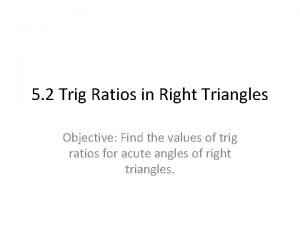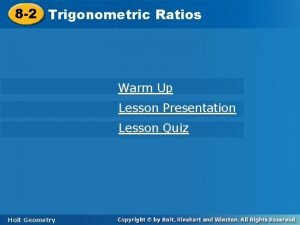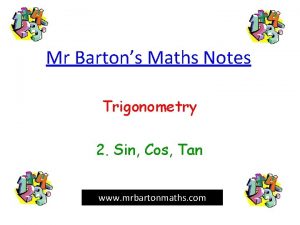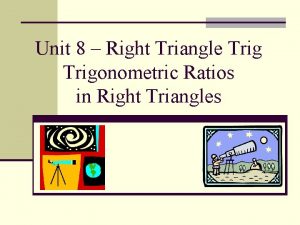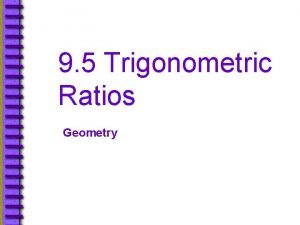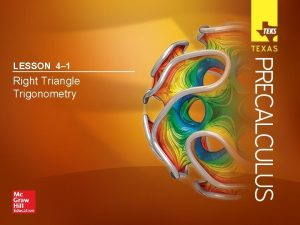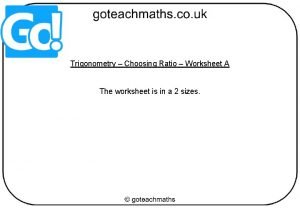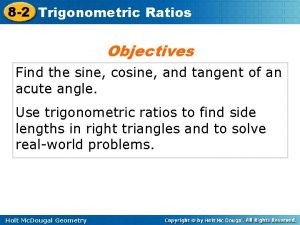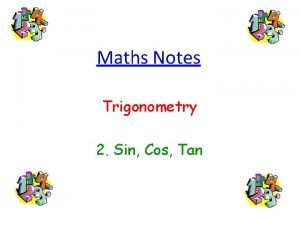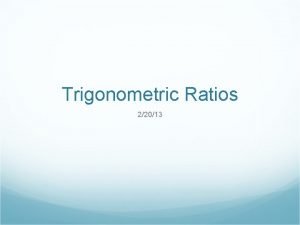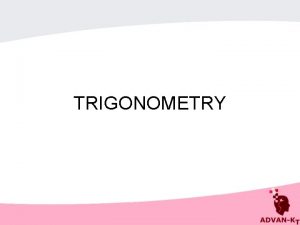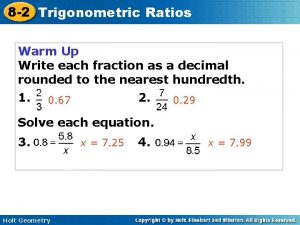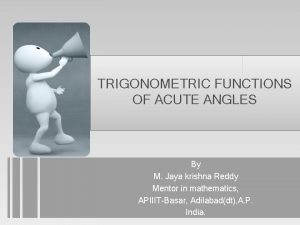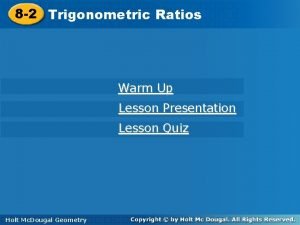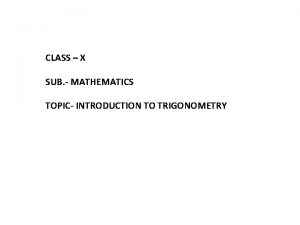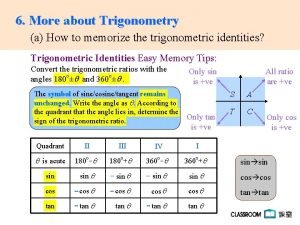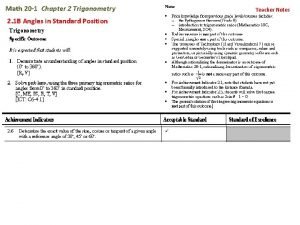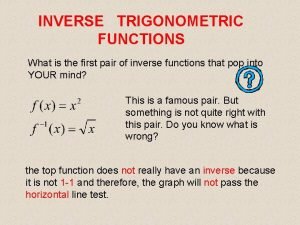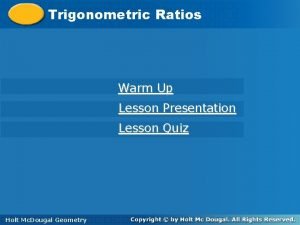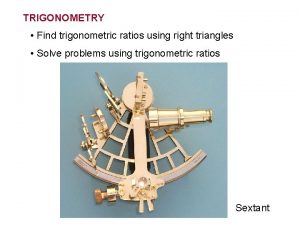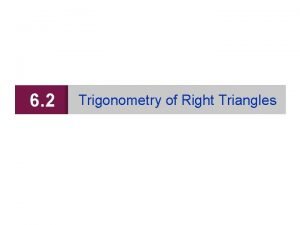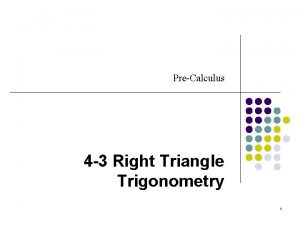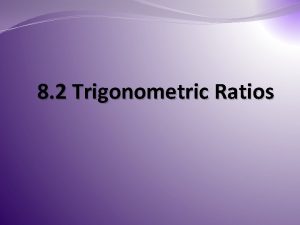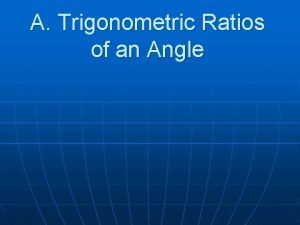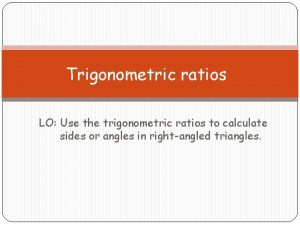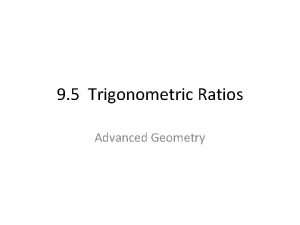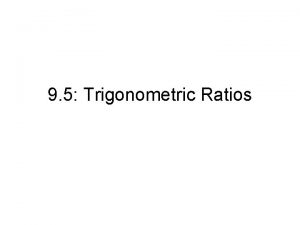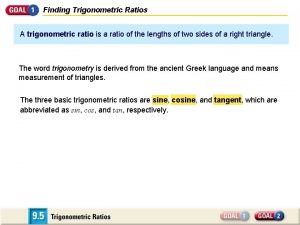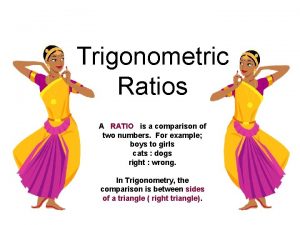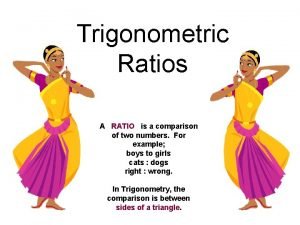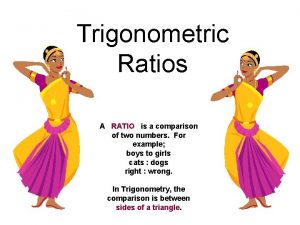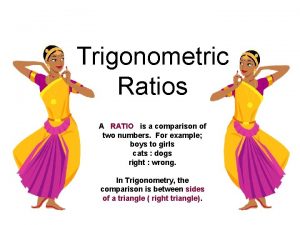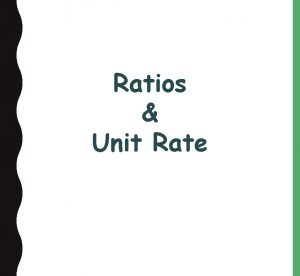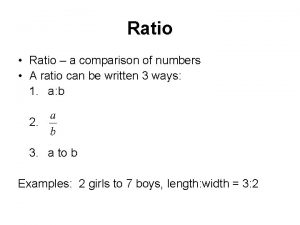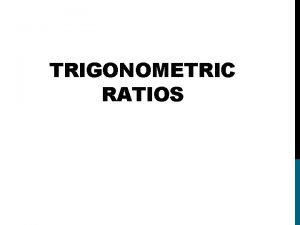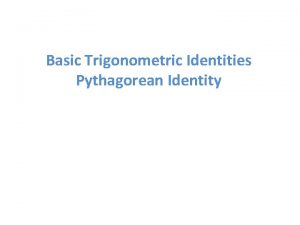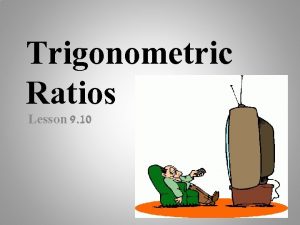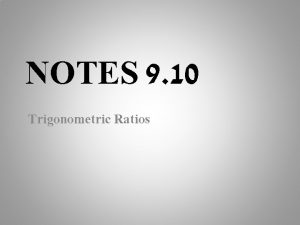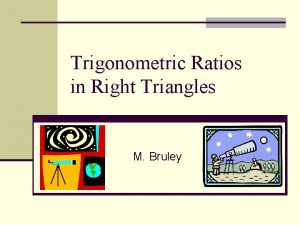Trigonometric Ratios A RATIO is a comparison of



























- Slides: 27

Trigonometric Ratios A RATIO is a comparison of two numbers. For example; 4 boys to 3 girls 5 cats : 3 dogs In Trigonometry, the comparison is between sides of a triangle ( right triangle).

Parts of a Right Triangle The hypotenuse will always be the longest side, and opposite from the right angle. The adjacent side is the side next to Angle A. Imagine that you are at Angle A looking into the triangle. The opposite side is the side that is on the opposite side of the triangle from Angle A.

Parts of a Right Triangle Now imagine that you move from Angle A to Angle B. From Angle B the adjacent side is the side next to Angle B. From Angle B the opposite side is the side that is on the opposite side of the triangle.

B Review For Angle A Hypotenuse This is the Opposite Side A This is the Adjacent Side For Angle B B Hypotenuse This is the Opposite Side This is the Adjacent Side A

Trig. Ratios Name “say” Abbreviation Abbrev. Ratio of an angle measure Sine Cosine Tangent Sin Cos Tan sinθ = opposite side hypotenuse cosθ = adjacent side hypotenuse tanθ =opposite side adjacent side Easy way to remember trig ratios: SOH CAH TOA Note: θ (Theta)is the symbol for an unknown angle

Similar Triangles and Trig Ratios P B 20 12 3 Q R 5 16 C A 4 Similar triangles: ratios of corresponding sides are the same Let’s look at the 3 basic Trig ratios for these 2 triangles Notice that the 3 basic Trig ratios are equivalent!!

Let’s practice… Write the ratio for sin A B Sin A = o = a h c c Write the ratio for cos A a C b Cos A = a = b h c A Write the ratio for tan A Let’s switch angles: Find the sin, cos and tan for Angle B: Sin B = b c Tan A = o = a a b Cos B = a c Tan B = b a

Make sure you have a calculator… I want to find Use these calculator keys sin, cos or tan ratio Angle measure Set your calculator to ‘Degree’…. . MODE (next to 2 nd button) Degree (third line down… highlight it) 2 nd Quit SIN COS TAN SIN-1 COS-1 TAN-1

Let’s practice… Find an angle that has a tangent (ratio) of 2 C 2 cm B 3 Round your answer to the nearest degree. 3 cm A Process: I want to find an ANGLE I was given the sides (ratio) Tangent is opp adj TAN-1(2/3) = 34°

Practice some more… Find tan A: Tan A = opp/adj = 12/21 24. 19 A 12 Tan A =. 5714 21 Find tan A: Tan A = 8/4 = 2 8 4 A

Ask yourself: In relation to the angle, what pieces do I have? 34° 15 cm Opposite and hypotenuse Ask yourself: x cm What trig ratio uses Opposite and Hypotenuse? SINE Set up the equation and solve: (15) Sin 34 = x (15) 15 (15)Sin 34 = x 8. 39 cm = x

Ask yourself: In relation to the angle, what pieces do I have? 53° 12 cm Opposite and adjacent x cm Ask yourself: What trig ratio uses Opposite and adjacent? tangent Set up the equation and solve: (12)Tan 53 = x (12) 12 (12)tan 53 = x 15. 92 cm = x

x cm Ask yourself: In relation to the angle, what pieces do I have? Adjacent and hypotenuse 68° 18 cm Ask yourself: What trig ratio uses adjacent and hypotnuse? cosine Set up the equation and solve: (x) Cos 68 = 18 (x) x (x)Cos 18 _____68 =_____ cos 68 X = 18 X = 48. 05 cm cos 68

42 cm 22 cm θ This time, you’re looking for theta. T HI S Ask yourself: IS In relation to the angle, what pieces IMPO RT do I have? Opposite and hypotenuse AN T! Ask yourself: ! What trig ratio uses opposite and hypotenuse? sine Set up the equation (remember you’re looking for theta): Sin θ = 22 42 Remember to use the inverse function when you find theta Sin -1 22 = θ 42 31. 59°= θ

You’re still looking for theta. TH IS θ IS IMP Ask yourself: 22 cm 17 cm What trig ratio uses the parts I was given? tangent Set it up, solve it, tell me what you get. tan θ = 17 22 tan -1 17 = θ 22 37. 69°= θ OR TA NT !!

Types of Angles • The angle that your line of sight makes with a line drawn horizontally. • Angle of Elevation • Angle of Depression

Indirect Measurement

WRITE THIS DOWN!!! • In general, for an acute angle A: – If sin A = x, then sin-1 x = m A – If cos A = y, then cos-1 y = m A – If tan A = z, then tan-1 z = m A The expression sin-1 x is read as “the inverse sine of x. ” • On your calculator, this means you will be punching the 2 nd function button usually in yellow prior to doing the calculation. This is to find the degree of the angle.

Example 1: • Solve the right triangle. Round the decimals to the nearest tenth. HINT: Start by using the Pythagorean Theorem. You have side a and side b. You don’t have the hypotenuse which is side c—directly across from the right angle.

Example 1: (hypotenuse)2 = (leg)2 + (leg)2 c 2 = 32 + 22 c 2 = 9 + 4 c 2 = 13 c = √ 13 c ≈ 3. 6 Pythagorean Theorem Substitute values Simplify Find the positive square root Use a calculator to approximate

Example 1 continued • Then use a calculator to find the measure of B: 2 nd function Tangent button 2 Divided by symbol 3 ≈ 33. 7°

Finally • Because A and B are complements, you can write m A = 90° - m B ≈ 90° - 33. 7° = 56. 3° The side lengths of the triangle are 2, 3 and √ 13, or about 3. 6. The triangle has one right angle and two acute angles whose measure about 33. 7° and 56. 3°.

Ex. 2: Solving a Right Triangle (h) • Solve the right triangle. 25° Round decimals to. You theare looking for opposite and nearest tenth. hypotenuse which is the sin ratio. sin H = 13 sin 25° = opp. hyp. h 13 13(0. 4226) ≈ h 5. 5 ≈ h Set up the correct ratio 13 Substitute values/multiply by reciprocal Substitute value from table or calculator Use your calculator to approximate.

Ex. 2: Solving a Right Triangle (g) • Solve the right triangle. 25° Round decimals to You theare looking for nearest tenth. adjacent and hypotenuse which is the cosine ratio. cos G = adj. hyp. g 13 cos 25° = 13 13(0. 9063) ≈ g 11. 8 ≈ g Set up the correct ratio 13 Substitute values/multiply by reciprocal Substitute value from table or calculator Use your calculator to approximate.

Using Right Triangles in Real Life • Space Shuttle: During its approach to Earth, the space shuttle’s glide angle changes. • A. When the shuttle’s altitude is about 15. 7 miles, its horizontal distance to the runway is about 59 miles. What is its glide angle? Round your answer to the nearest tenth.

Solution: • You know opposite and adjacent sides. If you take the opposite and divide it by the adjacent sides, then take the inverse tangent of the ratio, this will yield you the slide angle. Glide = x° 15. 7 miles 59 miles tan x° = opp. adj. 15. 7 Use correct ratio Substitute values 59 Key in calculator 2 nd function, tan 15. 7/59 ≈ 14. 9 When the space shuttle’s altitude is about 15. 7 miles, the glide angle is about 14. 9°.

B. Solution Glide = 19° h • When the space shuttle is 5 miles from the runway, its glide angle is about 19°. Find the shuttle’s altitude at this point in its descent. Round your answer to the nearest tenth. The shuttle’s altitude is about 1. 7 miles. 5 miles tan 19° = 5 tan 19° = opp. adj. Use correct ratio h Substitute values 5 h 5 5 Isolate h by multiplying by 5. 1. 7 ≈ h Approximate using calculator
 Cot identity
Cot identity Trig
Trig Write each fraction as a decimal
Write each fraction as a decimal Sin, cos tan formulas
Sin, cos tan formulas Trigonometric ratios maze
Trigonometric ratios maze Trigonometric ratios in right triangles
Trigonometric ratios in right triangles Trigonometric ratios
Trigonometric ratios Six trigonometric ratios
Six trigonometric ratios Trigonometric ratios in real life
Trigonometric ratios in real life Inverse trig function derivatives
Inverse trig function derivatives Trig ratio worksheets
Trig ratio worksheets 8-2 trigonometric ratios
8-2 trigonometric ratios Formula sin kos tan
Formula sin kos tan What is a trigonometric ratio
What is a trigonometric ratio Cos² 45ᵒ + 2 . cos 60ᵒ + sin² 45ᵒ adalah …
Cos² 45ᵒ + 2 . cos 60ᵒ + sin² 45ᵒ adalah … Lesson 8-2 trigonometric ratios
Lesson 8-2 trigonometric ratios Cos example
Cos example Trigonometric ratios of the angles
Trigonometric ratios of the angles 8-2 trigonometric ratios answers
8-2 trigonometric ratios answers How to remember trigonometric ratios
How to remember trigonometric ratios How to memorize trigonometric ratios
How to memorize trigonometric ratios Trigonometric ratios
Trigonometric ratios Inverse trig function calculator
Inverse trig function calculator Zishyp
Zishyp Magic triangle trigonometry
Magic triangle trigonometry Trig identities grade 11
Trig identities grade 11 Inverse cosine
Inverse cosine Identities trig
Identities trig

